CHRYSLER TOWN AND COUNTRY 2008 5.G Owners Manual
Manufacturer: CHRYSLER, Model Year: 2008, Model line: TOWN AND COUNTRY, Model: CHRYSLER TOWN AND COUNTRY 2008 5.GPages: 531, PDF Size: 4.51 MB
Page 401 of 531
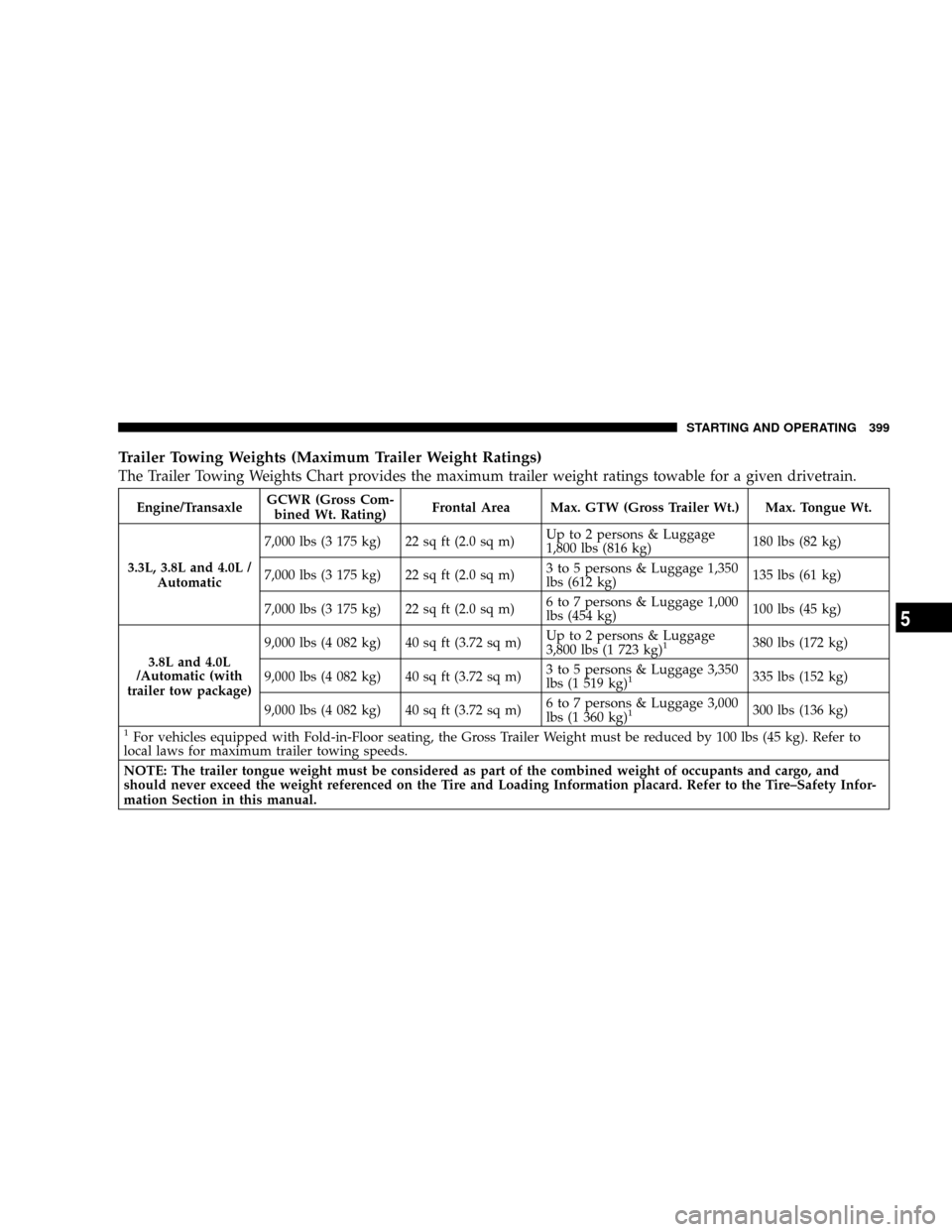
Trailer Towing Weights (Maximum Trailer Weight Ratings)
The Trailer Towing Weights Chart provides the maximum trailer weight ratings towable for a given drivetrain.
Engine/TransaxleGCWR (Gross Com-
bined Wt. Rating)Frontal Area Max. GTW (Gross Trailer Wt.) Max. Tongue Wt.
3.3L, 3.8L and 4.0L /
Automatic7,000 lbs (3 175 kg) 22 sq ft (2.0 sq m)Up to 2 persons & Luggage
1,800 lbs (816 kg)180 lbs (82 kg)
7,000 lbs (3 175 kg) 22 sq ft (2.0 sq m)3 to 5 persons & Luggage 1,350
lbs (612 kg)135 lbs (61 kg)
7,000 lbs (3 175 kg) 22 sq ft (2.0 sq m)6 to 7 persons & Luggage 1,000
lbs (454 kg)100 lbs (45 kg)
3.8L and 4.0L
/Automatic (with
trailer tow package)9,000 lbs (4 082 kg) 40 sq ft (3.72 sq m)Up to 2 persons & Luggage
3,800 lbs (1 723 kg)
1380 lbs (172 kg)
9,000 lbs (4 082 kg) 40 sq ft (3.72 sq m)3 to 5 persons & Luggage 3,350
lbs (1 519 kg)
1335 lbs (152 kg)
9,000 lbs (4 082 kg) 40 sq ft (3.72 sq m)6 to 7 persons & Luggage 3,000
lbs (1 360 kg)
1300 lbs (136 kg)
1For vehicles equipped with Fold-in-Floor seating, the Gross Trailer Weight must be reduced by 100 lbs (45 kg). Refer to
local laws for maximum trailer towing speeds.
NOTE: The trailer tongue weight must be considered as part of the combined weight of occupants and cargo, and
should never exceed the weight referenced on the Tire and Loading Information placard. Refer to the Tire±Safety Infor-
mation Section in this manual.
STARTING AND OPERATING 399
5
Page 402 of 531
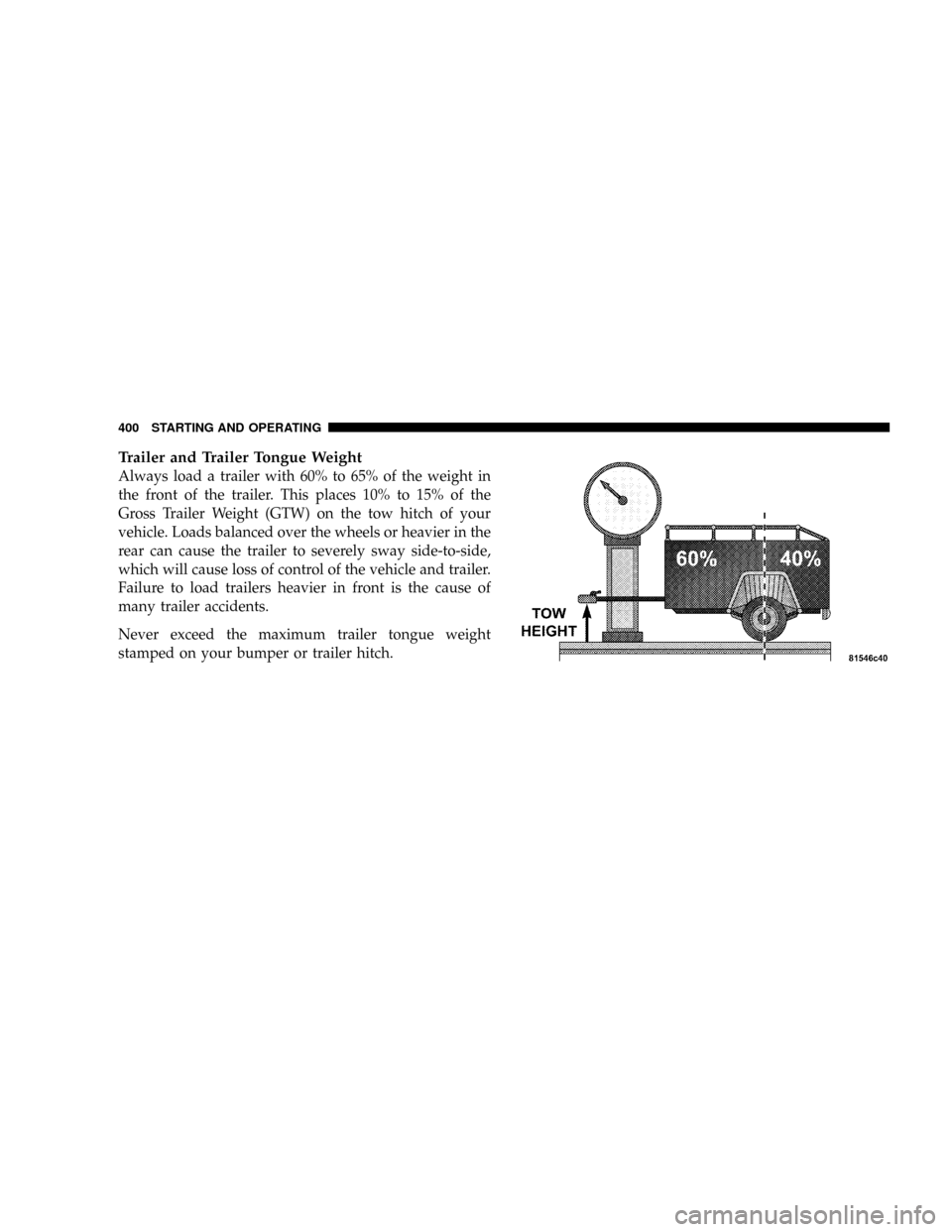
Trailer and Trailer Tongue Weight
Always load a trailer with 60% to 65% of the weight in
the front of the trailer. This places 10% to 15% of the
Gross Trailer Weight (GTW) on the tow hitch of your
vehicle. Loads balanced over the wheels or heavier in the
rear can cause the trailer to severely sway side-to-side,
which will cause loss of control of the vehicle and trailer.
Failure to load trailers heavier in front is the cause of
many trailer accidents.
Never exceed the maximum trailer tongue weight
stamped on your bumper or trailer hitch.
400 STARTING AND OPERATING
Page 403 of 531
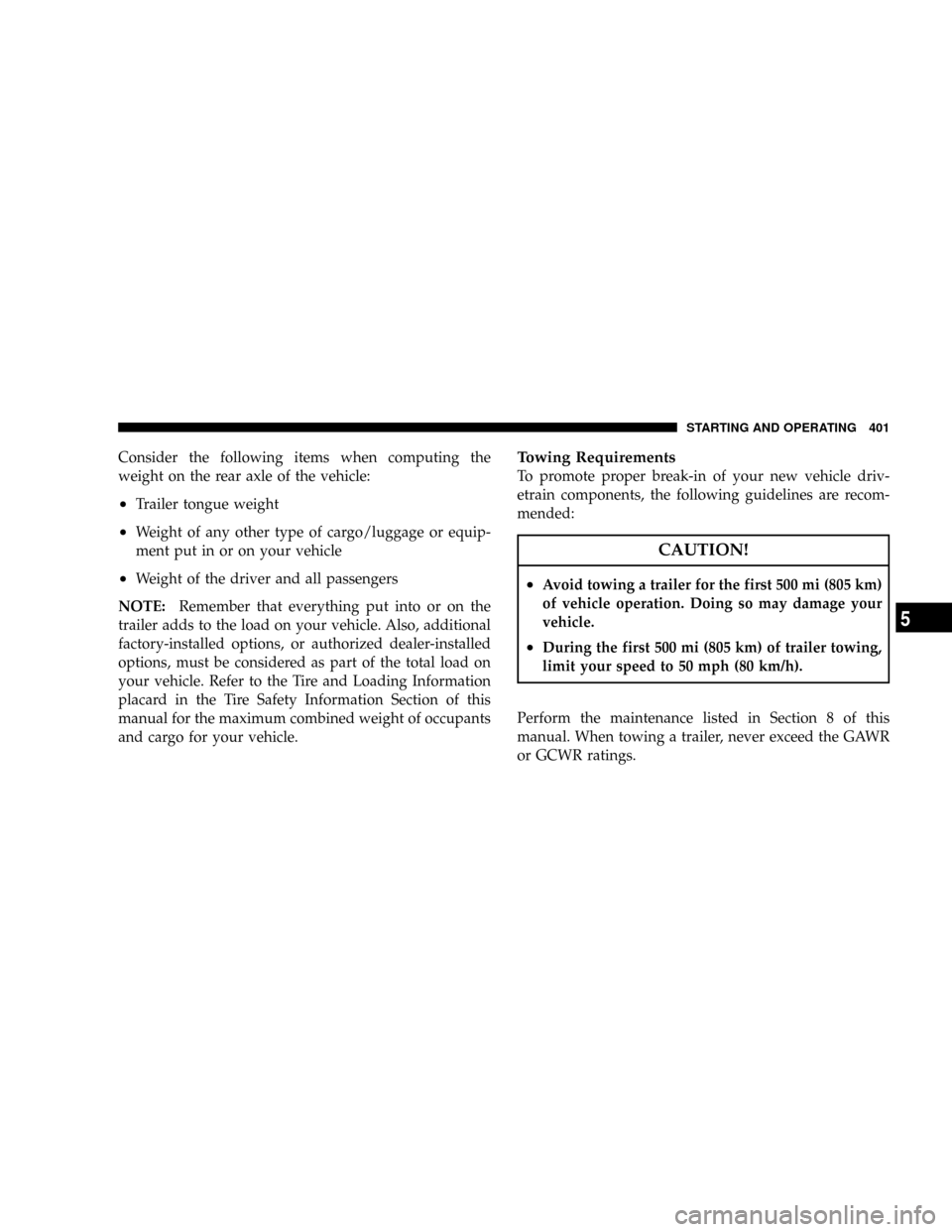
Consider the following items when computing the
weight on the rear axle of the vehicle:
²Trailer tongue weight
²Weight of any other type of cargo/luggage or equip-
ment put in or on your vehicle
²Weight of the driver and all passengers
NOTE:Remember that everything put into or on the
trailer adds to the load on your vehicle. Also, additional
factory-installed options, or authorized dealer-installed
options, must be considered as part of the total load on
your vehicle. Refer to the Tire and Loading Information
placard in the Tire Safety Information Section of this
manual for the maximum combined weight of occupants
and cargo for your vehicle.
Towing Requirements
To promote proper break-in of your new vehicle driv-
etrain components, the following guidelines are recom-
mended:
CAUTION!
²Avoid towing a trailer for the first 500 mi (805 km)
of vehicle operation. Doing so may damage your
vehicle.
²During the first 500 mi (805 km) of trailer towing,
limit your speed to 50 mph (80 km/h).
Perform the maintenance listed in Section 8 of this
manual. When towing a trailer, never exceed the GAWR
or GCWR ratings.
STARTING AND OPERATING 401
5
Page 404 of 531
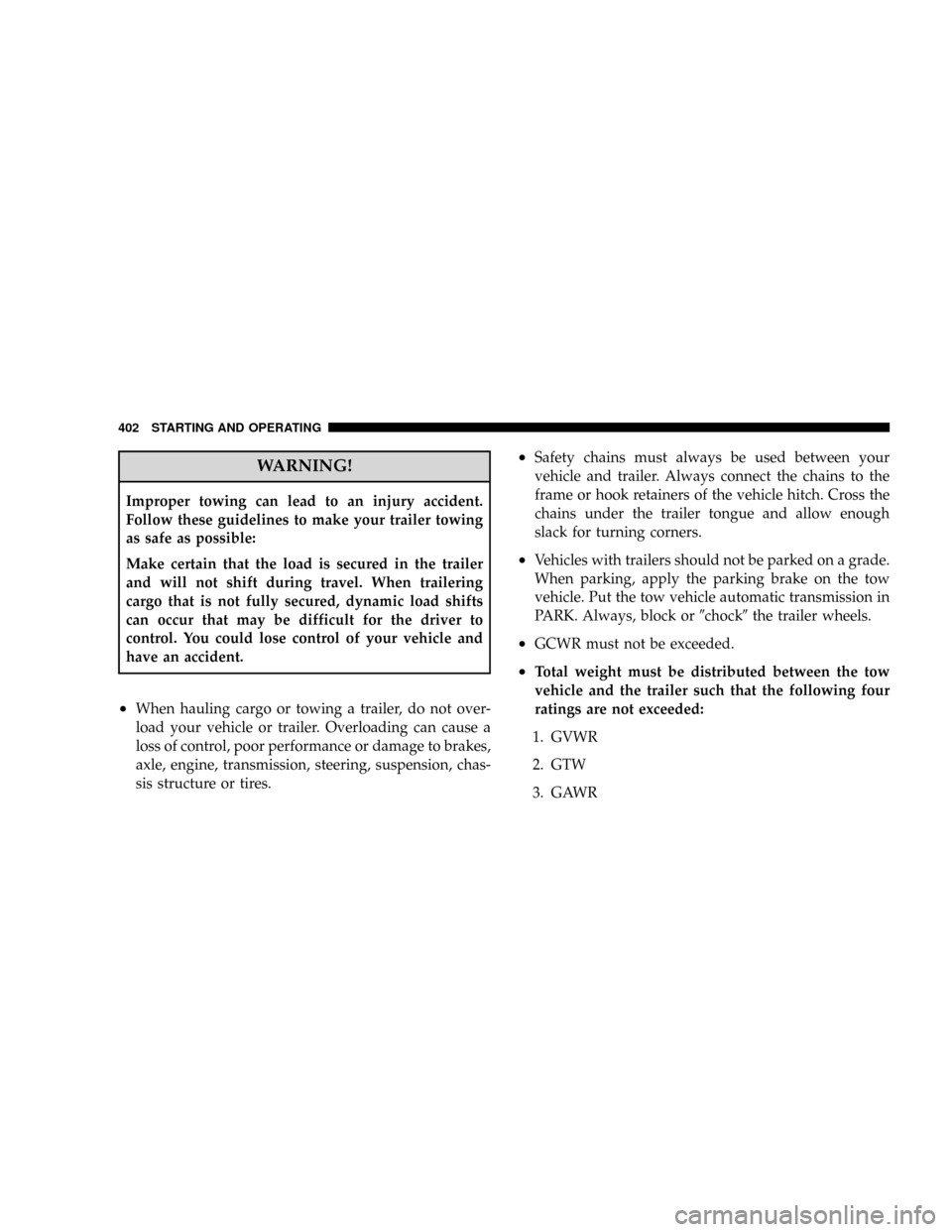
WARNING!
Improper towing can lead to an injury accident.
Follow these guidelines to make your trailer towing
as safe as possible:
Make certain that the load is secured in the trailer
and will not shift during travel. When trailering
cargo that is not fully secured, dynamic load shifts
can occur that may be difficult for the driver to
control. You could lose control of your vehicle and
have an accident.
²When hauling cargo or towing a trailer, do not over-
load your vehicle or trailer. Overloading can cause a
loss of control, poor performance or damage to brakes,
axle, engine, transmission, steering, suspension, chas-
sis structure or tires.
²Safety chains must always be used between your
vehicle and trailer. Always connect the chains to the
frame or hook retainers of the vehicle hitch. Cross the
chains under the trailer tongue and allow enough
slack for turning corners.
²Vehicles with trailers should not be parked on a grade.
When parking, apply the parking brake on the tow
vehicle. Put the tow vehicle automatic transmission in
PARK. Always, block or9chock9the trailer wheels.
²GCWR must not be exceeded.
²Total weight must be distributed between the tow
vehicle and the trailer such that the following four
ratings are not exceeded:
1. GVWR
2. GTW
3. GAWR
402 STARTING AND OPERATING
Page 405 of 531
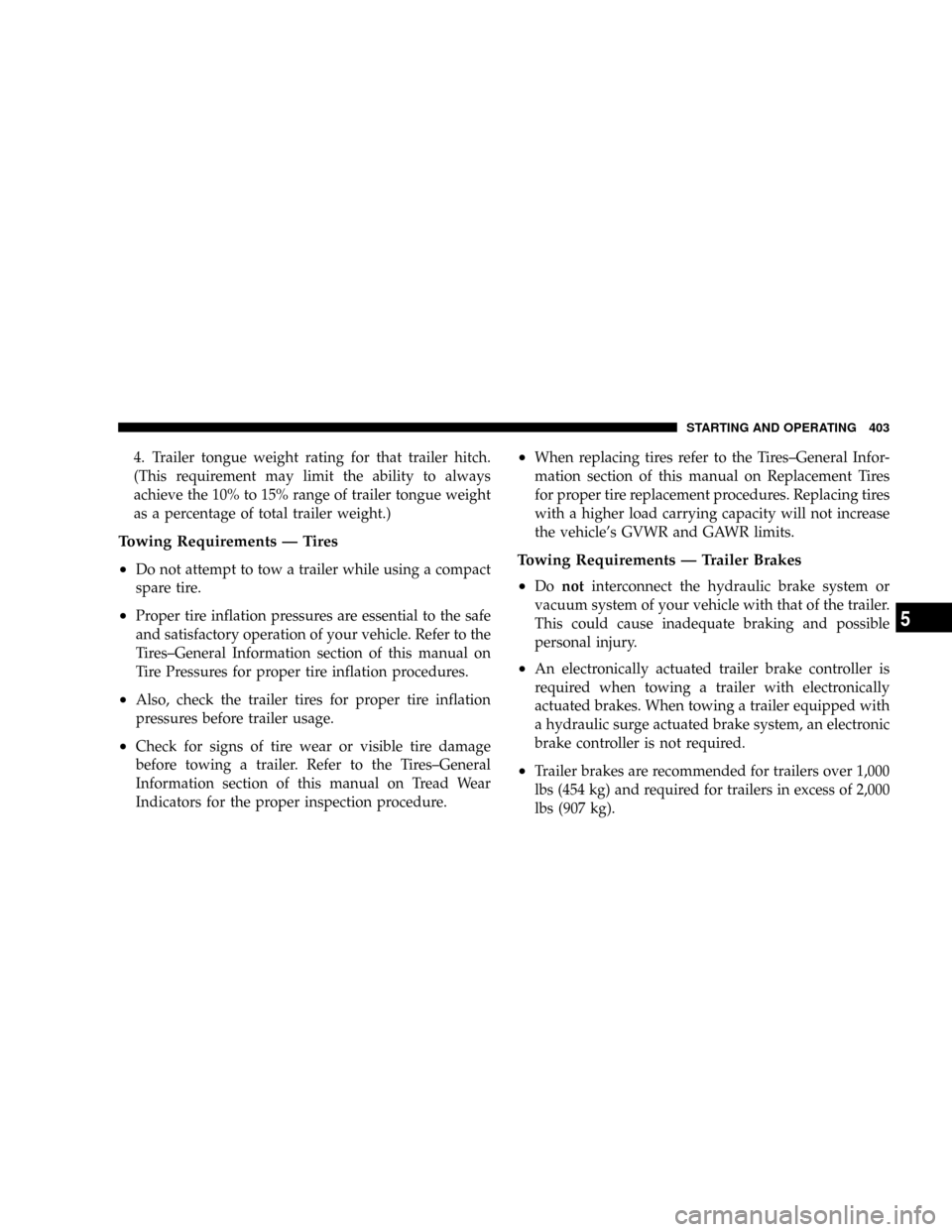
4. Trailer tongue weight rating for that trailer hitch.
(This requirement may limit the ability to always
achieve the 10% to 15% range of trailer tongue weight
as a percentage of total trailer weight.)
Towing Requirements Ð Tires
²
Do not attempt to tow a trailer while using a compact
spare tire.
²Proper tire inflation pressures are essential to the safe
and satisfactory operation of your vehicle. Refer to the
Tires±General Information section of this manual on
Tire Pressures for proper tire inflation procedures.
²Also, check the trailer tires for proper tire inflation
pressures before trailer usage.
²Check for signs of tire wear or visible tire damage
before towing a trailer. Refer to the Tires±General
Information section of this manual on Tread Wear
Indicators for the proper inspection procedure.
²When replacing tires refer to the Tires±General Infor-
mation section of this manual on Replacement Tires
for proper tire replacement procedures. Replacing tires
with a higher load carrying capacity will not increase
the vehicle's GVWR and GAWR limits.
Towing Requirements Ð Trailer Brakes
²
Donotinterconnect the hydraulic brake system or
vacuum system of your vehicle with that of the trailer.
This could cause inadequate braking and possible
personal injury.
²An electronically actuated trailer brake controller is
required when towing a trailer with electronically
actuated brakes. When towing a trailer equipped with
a hydraulic surge actuated brake system, an electronic
brake controller is not required.
²Trailer brakes are recommended for trailers over 1,000
lbs (454 kg) and required for trailers in excess of 2,000
lbs (907 kg).
STARTING AND OPERATING 403
5
Page 406 of 531
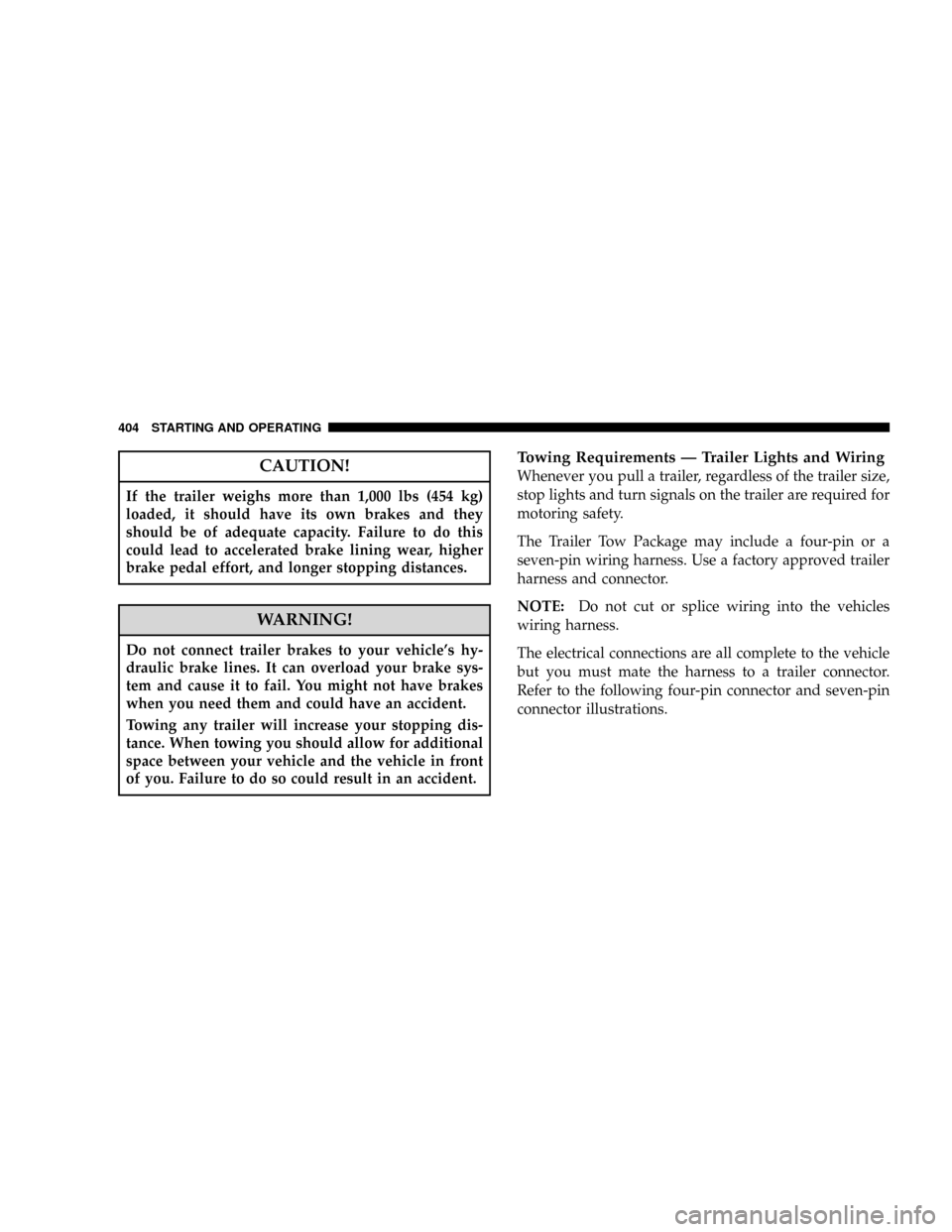
CAUTION!
If the trailer weighs more than 1,000 lbs (454 kg)
loaded, it should have its own brakes and they
should be of adequate capacity. Failure to do this
could lead to accelerated brake lining wear, higher
brake pedal effort, and longer stopping distances.
WARNING!
Do not connect trailer brakes to your vehicle's hy-
draulic brake lines. It can overload your brake sys-
tem and cause it to fail. You might not have brakes
when you need them and could have an accident.
Towing any trailer will increase your stopping dis-
tance. When towing you should allow for additional
space between your vehicle and the vehicle in front
of you. Failure to do so could result in an accident.
Towing Requirements Ð Trailer Lights and Wiring
Whenever you pull a trailer, regardless of the trailer size,
stop lights and turn signals on the trailer are required for
motoring safety.
The Trailer Tow Package may include a four-pin or a
seven-pin wiring harness. Use a factory approved trailer
harness and connector.
NOTE:Do not cut or splice wiring into the vehicles
wiring harness.
The electrical connections are all complete to the vehicle
but you must mate the harness to a trailer connector.
Refer to the following four-pin connector and seven-pin
connector illustrations.
404 STARTING AND OPERATING
Page 407 of 531
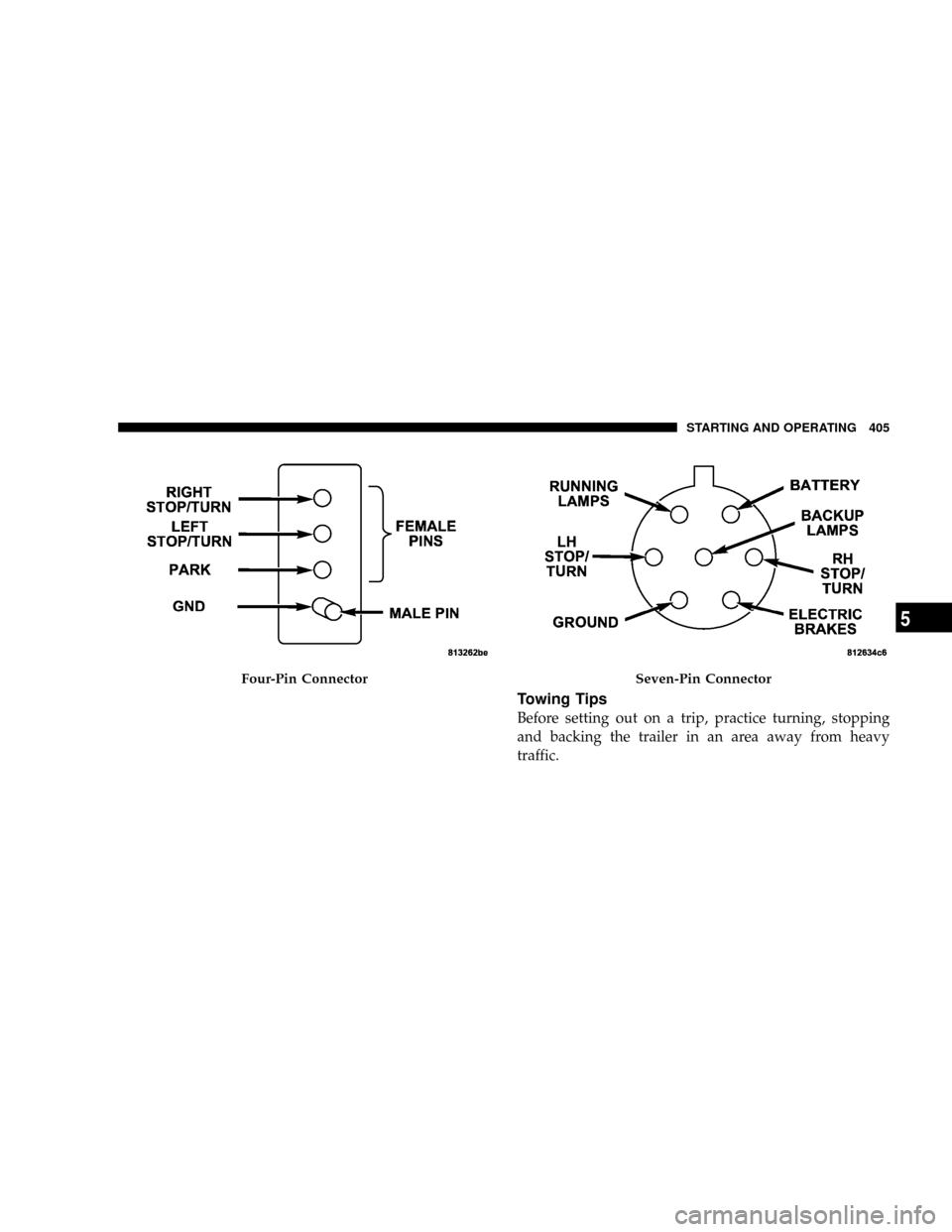
Towing Tips
Before setting out on a trip, practice turning, stopping
and backing the trailer in an area away from heavy
traffic.
Four-Pin ConnectorSeven-Pin Connector
STARTING AND OPERATING 405
5
Page 408 of 531
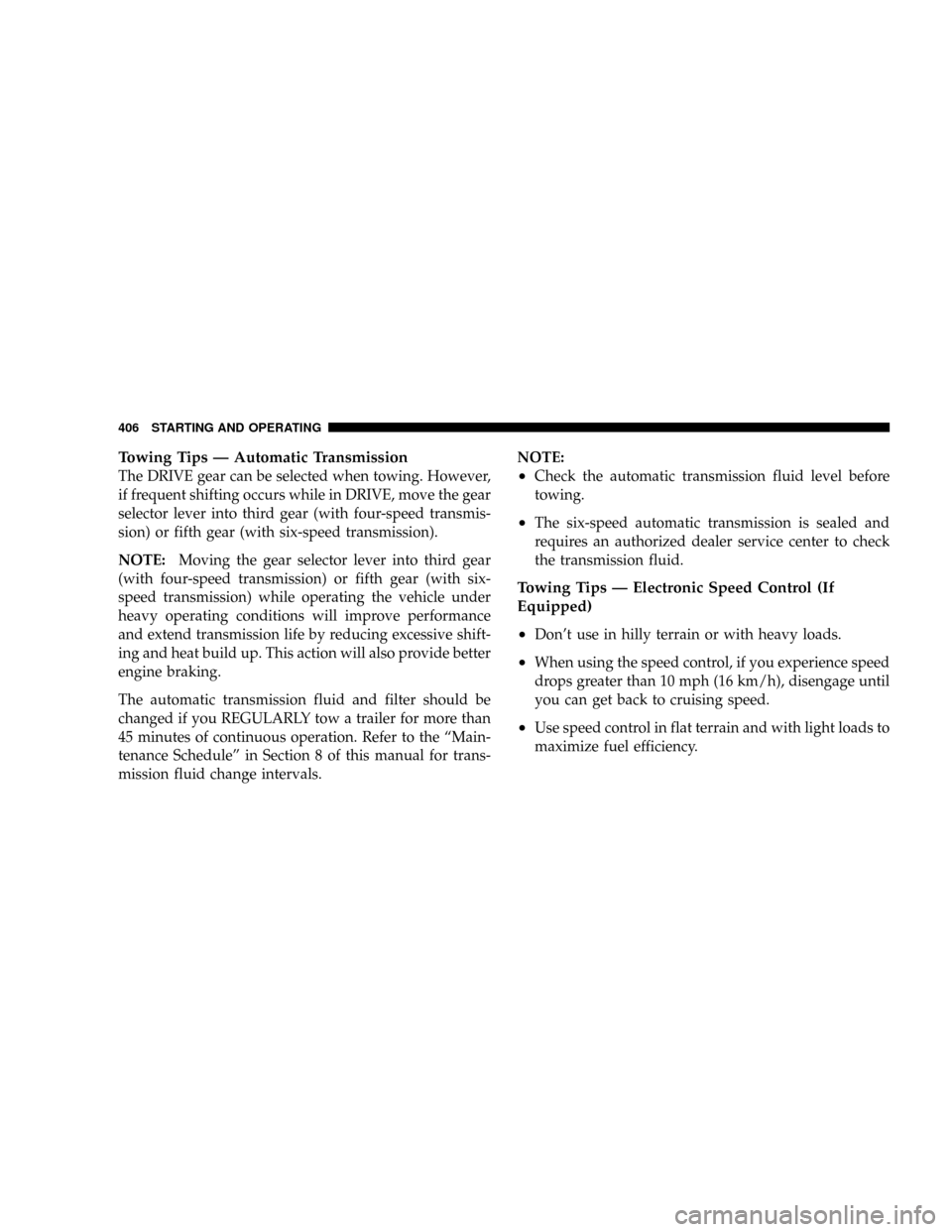
Towing Tips Ð Automatic Transmission
The DRIVE gear can be selected when towing. However,
if frequent shifting occurs while in DRIVE, move the gear
selector lever into third gear (with four-speed transmis-
sion) or fifth gear (with six-speed transmission).
NOTE:Moving the gear selector lever into third gear
(with four-speed transmission) or fifth gear (with six-
speed transmission) while operating the vehicle under
heavy operating conditions will improve performance
and extend transmission life by reducing excessive shift-
ing and heat build up. This action will also provide better
engine braking.
The automatic transmission fluid and filter should be
changed if you REGULARLY tow a trailer for more than
45 minutes of continuous operation. Refer to the ªMain-
tenance Scheduleº in Section 8 of this manual for trans-
mission fluid change intervals.NOTE:²Check the automatic transmission fluid level before
towing.
²The six-speed automatic transmission is sealed and
requires an authorized dealer service center to check
the transmission fluid.
Towing Tips Ð Electronic Speed Control (If
Equipped)
²
Don't use in hilly terrain or with heavy loads.
²When using the speed control, if you experience speed
drops greater than 10 mph (16 km/h), disengage until
you can get back to cruising speed.
²Use speed control in flat terrain and with light loads to
maximize fuel efficiency.
406 STARTING AND OPERATING
Page 409 of 531
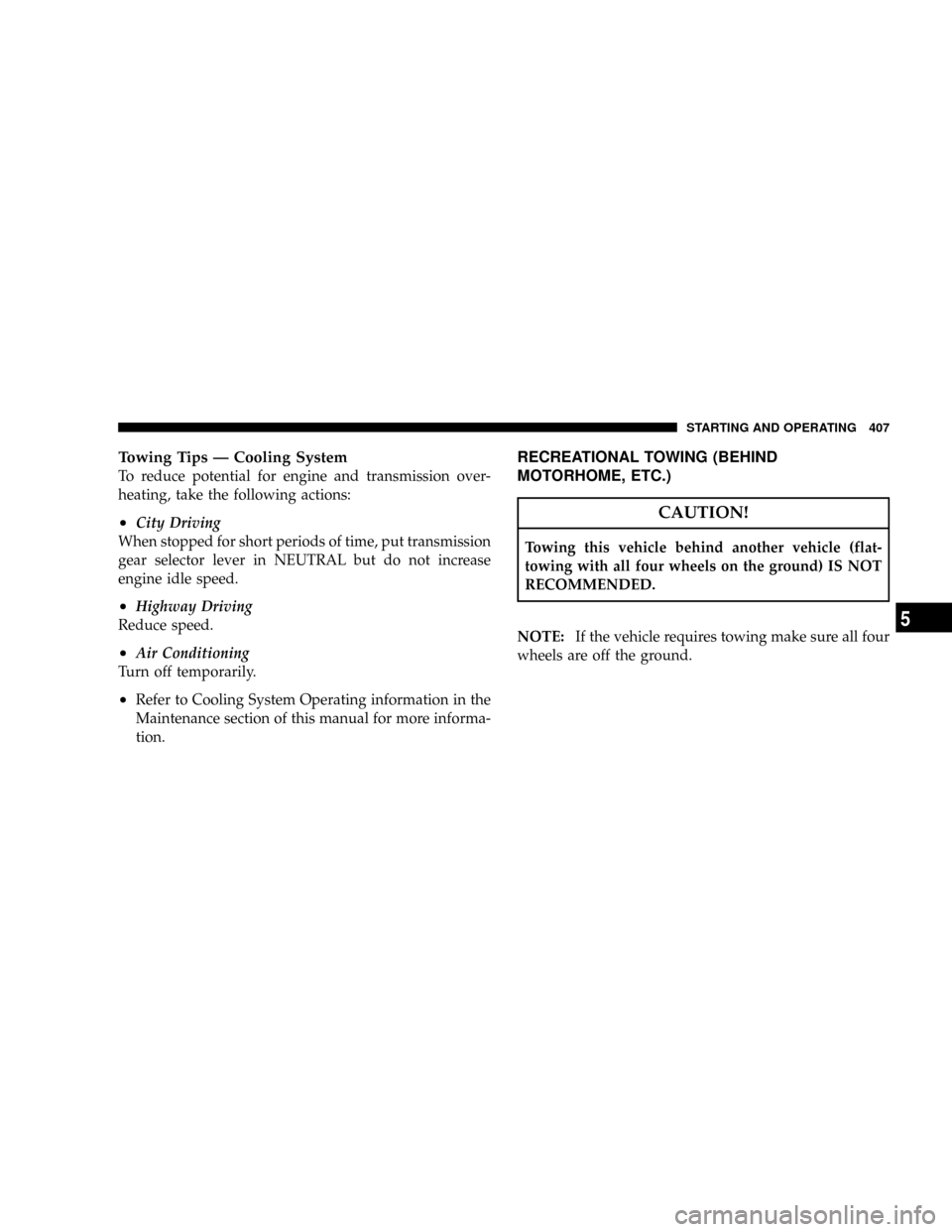
Towing Tips Ð Cooling System
To reduce potential for engine and transmission over-
heating, take the following actions:
²City Driving
When stopped for short periods of time, put transmission
gear selector lever in NEUTRAL but do not increase
engine idle speed.
²Highway Driving
Reduce speed.
²Air Conditioning
Turn off temporarily.
²Refer to Cooling System Operating information in the
Maintenance section of this manual for more informa-
tion.
RECREATIONAL TOWING (BEHIND
MOTORHOME, ETC.)
CAUTION!
Towing this vehicle behind another vehicle (flat-
towing with all four wheels on the ground) IS NOT
RECOMMENDED.
NOTE:If the vehicle requires towing make sure all four
wheels are off the ground.
STARTING AND OPERATING 407
5
Page 410 of 531
